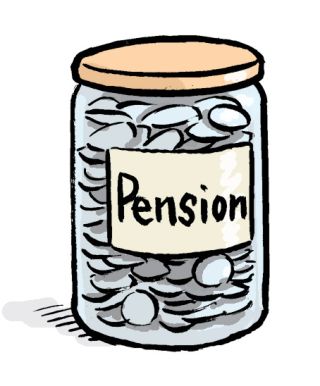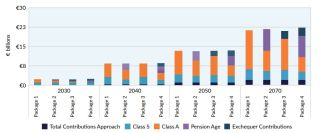Ireland needs a Universal State Social Welfare Pension

The latest data from the CSO indicates that more than one third of people aged 20-69 do not have any pension support outside of State payments. With an increasing and ageing population, there are concerns about the sustainability of State pension coverage, however with increasing numbers of older people continuing to pay market rents post-retirement, the societal cost of reductions to coverage could be catastrophic.
Commission on Pensions Report
The final report of the Commission on Pensions, published in October 2021, suggested a series of four reform packages to address the sustainability of the State pension. The first of these packages recommends increases to PRSI rates to increase the pension "pot". For the self-employed (Class S), the increase suggested is from 4 per cent to 10 per cent by 2030, then to a higher Class A Employer rate of a 3.25 percentage point increase by 2040 and a 1.1 percentage point increase by 2050. For employers and employees, the recommendation consists of a 0.6 percentage point increase by 2030; 1.6 percentage point increase by 2040; and 1.1 percentage point increase by 2050.
Package 2 suggests both PRSI rate changes and an increase to the State Pension age. Self-employed rates would incrase from 4 per cent to 10 per cent by 2030, then to the higher Class A Employer rate with a 2.95 percentage point increase by 2040, and a 0.15 percentag point increase by 2050. Employers and employees would see their rate of PRSI increase by 0.3 percentage points by 2030, 1.6 percentage points by 2040, and 0.15 percentage points by 2050. And then, of course, there's the recommended increase to the pension age: from 2028, the pension age would increase by 3 months each year, reaching 67 in 2031. Further incrases would follow of 3 months every 2 yeas from 2033 until the pension age reached 68 in 2039.
Package 3 consists of both PRSI rates and Exchequer contributions. PRSI rates for the self-employed would incrase from 4 per cent to 10 per cent by 2030, then to higher Class A Employer rate, increasing by 2.8 percentage points by 2040, and 0.9 percentage points by 2050. Employers and employees would see increases of 0.2 percentage points by 2030, 1.55 percentage points by 2040, and 0.9 percentage points by 2050. Meanwhile, Exchequer contributions would amount to 10 per cent of SPC (State Pension Contributory) expenditure.
And finally, to Package 4. This combines PRSI rate increases, an increase to the State pension age and Exchequer contributions. Under this package, the self-employed would see an increase in PRSI from 4 per cent to 10 per cent to 2030, then to higher rate Class A Employer rate, a 2.4 percentage point increase to 2040 and a 0.1 percentage point increase to 2050. Employers and employees would have no increase by 2030, but thereafter would see an increase of 1.35 percentage points by 2040, and 0.1 percentage points by 2050. The pension age would increase by 3 months each year from 2028, reaching 67 in 2031, and then by 3 months every 2 years from 2033, reaching 68 in 2039. The recommendation for Exchequer contributions amounts to 10 per cent of SPC expenditure.
The impact of the various packages on projected shortfalls is set out in the report, and in Figure 1 below.
Figure 1: Contributions of policy reforms to projected shorfalls, Packages 1 - 4 (€ billions)

Source: Commission on Pensions (2021): Report of the Commission on Pensions. Stationery Press: Dublin p.63
A report in the Business Post on Sunday, 28th February 2022[1] suggests a lack of public support for the packages proposed by the Commission. According to the Business Post / Red C poll, just 13 per cent of those surveyed fully supported an increase in the pension age, 21 per cent somewhat supported it, and 61 per cent did not support it. When asked about increases in the rates of PRSI, 11 per cent fully supported the increase in employee PRSI, and 13 per cent fully supported the increase to self-employed PRSI. This compares to 51 per cent of respondents who did not support either increase. Support was higher for employers' PRSI, with 25 per cent fully supporting it and 36 per cent somewhat supporting it. Only 28 per cent did not support this proposal.
Joint Committee Report
Meanwhile, the Joint Committee on Social Protection, Community and Rural Development and the Islands published a report in February 2022 having reviewed the Commission's proposals. In its recommendations, the Committee said:
- The qualifying age for the State pension should remain at age 66;
- Legislation should be developed to ban the use of mandatory retirement clauses in existing as well as new employment contracts.
- The proposal to move workers over the age of 66 to Class K PRSI is rejected;
- Changes to Employers’ PRSI contribution rates should be examined by the Commission on Welfare and Taxation to determine the fairest way to increase Employers’ PRSI contribution rates.
- The cap on credited contributions should be eliminated in view of the importance of nurturing and caring work in our society.
Pension Dependencies
Dependency rates are certainly increasing. In a paper presented to the Social Justice Ireland Annual Social Policy Conference in 2019, CSO Statistician, James Hegarty, presented on the challenges and opportunities of Ireland's changing demographics. Hegarty's calculations suggest that the dependancy ratio will increase from 5:1 in 2016 (that is, five working age people to every person aged 65+) to 2:5.1 (two working age people to 5.1 people aged 65+). That's a significant shift. According to the 2020 Annual Statistics Report published by the Department of Social Protection, pensions increased from €6.09 billion in 2011 to €8.48 billion in 2020.
Social Justice Ireland's Proposal
Government should consider the implementation of a universal state social welfare pension as a means of ensuring all senior citizens in Irish society have sufficient income to live life with dignity. This could be paid for through changes to the structure of pension tax reliefs and a modest increase in PRSI. Making entitlement to the state pension universal, and paying it at the current rate of the State Pension (Contributory) would close the gaps in coverage that exist, and help ensure that all our elderly have enough money to live a dignified retirement.
While the state social welfare pension does a reasonable job of ameliorating poverty among Ireland’s elderly, there are still many who fall between the cracks. It is women who suffer most. Fewer women than men qualify for the state pension and those who do tend to receive less. Often these are women who have spent their lives in caring roles – something government needs to value more than it does.
At the moment, the entire thrust of pension policy in Ireland seems to be focused on the private sector, and how expanding coverage there will reduce reliance on the state in retirement. This has involved directing very expensive tax breaks towards the very profitable private pensions industry. While in theory this makes sense, the only way this policy can save the state money is if the plan is to erode the long-term value of the state social welfare pension – something that should be strongly opposed.
Yet it is the state pension which sets the floor on which the vast majority of retirees in Ireland stand. Pension-related tax incentives cost the taxpayers billions of euros every year, but benefit only those who can already afford to save for their retirement. In fact more than 70 per cent of these tax breaks go to people in the top 20 per cent of earners.
If the purpose of a national pension system is to allow a country’s elderly and disabled to retire from work without fear of poverty in retirement, it would make sense that the vast majority of resources within the system be allocated to providing a flat-rate universal pension to all those over the State Pension Age, and maintaining it at a level which allowed retirees to achieve what might be considered a socially acceptable standard of living. Instead, billions of euros are being spent on a private pension system characterised by low coverage rates and a poor record of achieving income adequacy.
Information about Social Justice Ireland’s Universal State Pension proposal can be accessed here.
An analysis of what pension tax reliefs actually achieve for the state can be accessed here.